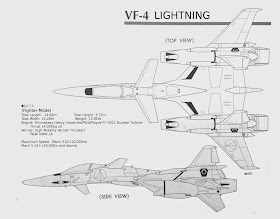VF-4 Lightning III
A VF-4G Lightning III from Alaska's Elmendorf base on its maiden flight in 2020.
This picture was taken from the rear seat of an accompanying VF-1D.
The largest change from the VF-1 series was the VF-4's greatly expanded capabilities in space, though atmospheric performance was approximately on par with that of the VF-1. Once at high altitudes, however, the VF-4 displayed greatly increased mobility.
The VF series prototype and adoption process was typically a competitive process between several manufacturers. The prototype known as the VF-X-2 was developed concurrently with the VF-1, but incorporated a much greater level of OTM, resulting in numerous development delays. However, before an actual prototype could be constructed, the attack of the Boldoza fleet completely annihilated all Earth-Based forces, and so development was ceased, creating a ‘ghost fighter’.
Also in the prototype stage was the VF-X-3, which was slated to be trialed in the VF-4 competition as the successor to the VF-1, which had already entered the testing phase.
The head planner of this project was the man credited with the development of the Valkyrie, commonly known as the ‘father of the variable fighter’, Colonel Chris J Takatoku. The primary development site was undertaken at the Grand Cannon IV base on Earth, with development plans proceeding as far as the construction of a full scale mockup. With the VF-1 development team at the core of the project, the VF-X-3 was able to produce results that surpassed the capabilities of the VF-4, but with the destruction of the Grand Cannon IV facility, Chief Takatoku's whereabouts were unknown, and the mockup and most design data was lost. A small number of photographs and a few parts which were sent to a manufacturing plant in space are all that remains of this design, which were used to extrapolate the estimated capabilities of the completed machine.
The VF-4 was an evolution on another prototype being developed concurrently with the VF-X-3, the VF-X-4. Development proceeded in earnest with existing OTM being supplemented by Zentraedi technology knowhow to create a considerably different style of aircraft than the VF-1. In order to accelerate the development of the new fighter, usage of existing VF-1 parts was encouraged, and the first prototype, the VF-X-4V1 had a 35% parts commonality with the VF-1. The expanded prototype, the VF-4A-0 featured less than 25% parts commonality, but in mock combat trials during the development program, it was seen to surpass the combat abilities of the VF-1 by 40%.
The external form of the aircraft was of a triple body type, with twin engine nacelles containing propellant tanks and weapons, with the pilot and cockpit block in the center. This unique shape led to pilots giving it the nickname ‘Arrow’.
The engine nacelles featured large beam cannons, and another notable point are the six semi-recessed long range missiles installed on the nacelles. During test flights, many ace pilots who participated in the Boldoza war gave input on the design, and one prominent name in particular appears on this list of test pilots: Hikaru Ichijo.
With the VF-4, all-around performance demands were superseded by an emphasis on air combat mobility, and particular emphasis was placed on performance in space combat, which led to somewhat reduced performance in atmospheric conditions, and following the introduction of the VF-5000, most VF-4s were deployed with space-bound units.
Production was halted after 2022, and by 2030, the role of space superiority fighter fell to the VF-11, with a total production of 8,245 VF-4 airframes.
Though the official name of this fighter was the ‘Lightning III’, many recorded instances of all Variable Fighters being referred to as ‘Valkyries’ exist, which is technically the official name of only the VF-1 series.
VF 4 Squadron Colors





No comments:
Post a Comment